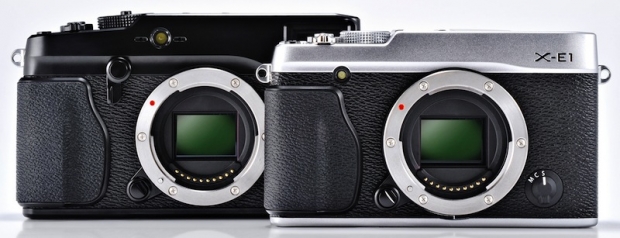
Unless they're identical twins, siblings are never exactly alike. So Fujifilm's newest mirror-less camera, the X-E1, was never going to be a faithfully scaled-down version of the X-Pro1. Sure, it has a 16 megapixel APS-C X-Trans CMOS sensor, the same as the X-Pro1, but it doesn't have the hybrid viewfinder; instead it has a high definition 2.36 million dot OLED eletronic viewfinder. Fujifilm believes that this electronic viewfinder can provide 'an experience similar to an optical viewfinder,' though. And of course, it takes X-mount lenses.
Its sensitivity ranges from ISO 200 to 6,400, extendable to 100, 12,800, and 25,600. If you want to employ the ISO auto facility, it takes in 400 to 6,400, which is actually a smidge of an improvement on the X-Pro1, which only went up to 3,200.
You can make full HD video (1920×1080) at 24 frames per second, and there's an external microphone jack to help get the sound right.
Whilst that might seem a neat package of a camera, it isn't all.
Looking back; thinking forward
Digital might offer flexibility that dips its toes into the rivers bounding our wildest dreams, but it doesn't get everything right. Frequently, people bemoan the loss of texture and colour in digital images, and from Fuji's perspective, they needed to go back to film to get that right.
The X-Trans CMOS sensor (already seen in the X-Pro1) comprises random arrangements of 6×6 pixel sets, reminiscent of the randomly scattered grains of fine silver halide on film, instead of perfectly organised sets. This colour filter array should minimise moiré and false colours without the need for an optical low pass filter. Bring on the bright, clear renditions of images!
Perfect order and regimentation might be necessary in our photo libraries, but not on our sensors, it would seem.
A film for the future?
Earlier this year Fujifilm announced that it's ceasing production of some of film formats, notably in the Velvia range. For lots of people who shoot on film, this is hugely disappointing. Whilst it's debatable if digital can ever faithfully recreate film effects, Fuji isn't dismissing the possibility and seems to be taking it as a challenge. The X-E1 comes with a series of film simulation modes that aim to recreate the effects of shooting on particular Fujichrome films.
Velvia, Astia, and Provia are all covered, there are two colour negative film settings, two indoor shooting options, and three filters covering monochrome and sepia. There's also a bracketing function that allows you to apply three film simulation to the same exposure.
If these simulations are effective, and don't look too much like digital-made-to-look-like-film, then it's an awesome option for people who miss the texture of film but love the flexibility of digital. But neither should the business ramefications for Fujifilm be overlooked.
I certainly don't think that Fujifilm will be shutting down its film production facilities overnight; I don't even think that they'll do it soon. Too many people are still using it and it is trendy. However, if this technology does prove successful, there will be less and less reason to persist in its manufacture. It's as if Fujifilm is testing viability and reaction here, and setting in place its contingency plans for a film-free future.
Availability
The Fujifilm X-E1 is available in black or silver. Body-only, you're looking at $1000, come November. You might want to add one of the new X-mount lenses to your shopping list. There's a new 18-55mm ƒ/2.8 - 4 or a 14mm ƒ/2.8 on offer at $900 and $700 respectively.





